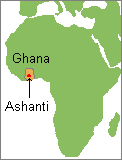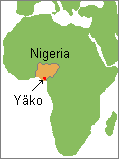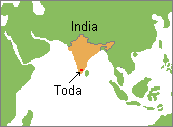The Anthropology Tutorials website will be taken offline on January 9, 2026.
Due to federal accessibility requirements taking effect in 2026, we will be removing this site. If you use materials from this site in your courses or research, please seek alternative resources.
Descent
Principles: Part 1
Kinship
is reckoned in a number of different ways around the world, resulting in a variety of
types of descent patterns and kin groups.
Anthropologists frequently use diagrams to illustrate kinship relationships
to make them more understandable. The
symbols shown here are usually employed. They may be combined, as in the example
below on the right, to represent a family consisting of a married couple and their
children.

In kinship diagrams, one
individual is usually labeled as ego
 . This is the person to whom all kinship
relationships are referred. In the case below on the right, ego has a brother (Br),
sister (Si), father (Fa), and mother (Mo). Note also that ego is shown as being
gender nonspecific--that is, either male or female.
. This is the person to whom all kinship
relationships are referred. In the case below on the right, ego has a brother (Br),
sister (Si), father (Fa), and mother (Mo). Note also that ego is shown as being
gender nonspecific--that is, either male or female.

Unilineal
Descent
Most cultures severely limit
the range of people through whom descent is traced by using a
unilineal
 descent
principle. This traces descent only through a single line of ancestors, male or
female. Both males and females are members of a unilineal family, but descent links
are only recognized through relatives of one gender. The two basic forms of
unilineal descent are referred to as patrilineal
descent
principle. This traces descent only through a single line of ancestors, male or
female. Both males and females are members of a unilineal family, but descent links
are only recognized through relatives of one gender. The two basic forms of
unilineal descent are referred to as patrilineal
 and matrilineal
and matrilineal
 .
.
With patrilineal descent,
both males and females belong to their father's kin group but not their mother's.
However, only males pass on their family identity to their children. A woman's
children are members of her husband's patrilineal line. The red people
in the diagram below are
related to each other patrilineally.

The form of unilineal
descent that follows a female line is known as matrilineal. When using this
pattern, individuals are relatives if they can trace descent through females to the same
female ancestor. While both male and female children are members of their mother's
matrilineal descent group, only daughters can pass on the family line to their
offspring. The green people below are related to each other matrilineally.

In societies using matrilineal
descent, the social relationship between children and their biological father tends to
be different than most people would expect due to the fact that he is not a member of their matrilineal family. In
the case of ego below, the man who would have the formal responsibilities that European
cultures assign to a father would be his mother's brother (MoBr), since he is the closest
elder male kinsmen. Ego's father would have the same
kind of responsibilities for his sister's children.

Inheritance patterns for men in matrilineal societies
also
often reflect the importance of the mother's brother. For example, in the Ashanti
Kingdom of Central Ghana, a king traditionally passes his title and status on to his
sister's son. A king's own biological son does not inherit the kingship because he
is not a member of the ruling matrilineal family group.
Women usually inherit
status and property directly from their mothers in matrilineal societies.
Unilineal descent has been
found most commonly, but not exclusively, among materially rich
foragers,
small-scale farmers, and nomadic pastoralists
 .
The common factors for these types of societies are small populations that usually have
more than adequate food supplies. Until the early 20th century, approximately 60%
of all societies traced descent unilineally. Since then, many of these societies
have disappeared or have been absorbed by larger societies that follow other rules of
descent.
.
The common factors for these types of societies are small populations that usually have
more than adequate food supplies. Until the early 20th century, approximately 60%
of all societies traced descent unilineally. Since then, many of these societies
have disappeared or have been absorbed by larger societies that follow other rules of
descent.
Cognatic Descent
At least 40% of
the
societies around the world today trace descent through both the mother's and
the father's
ancestors to some degree. They follow one of several nonunilineal or
cognatic
 descent
principles. The result is
usually more varied and complex family systems than are found
in societies with
patrilineal or matrilineal descent patterns. Cognatic
descent is known to occur in four variations: bilineal, ambilineal, parallel, and
bilateral descent. By far the most common pattern is bilateral
descent, which is commonly used in European cultures. It is described in the next section of this tutorial.
descent
principles. The result is
usually more varied and complex family systems than are found
in societies with
patrilineal or matrilineal descent patterns. Cognatic
descent is known to occur in four variations: bilineal, ambilineal, parallel, and
bilateral descent. By far the most common pattern is bilateral
descent, which is commonly used in European cultures. It is described in the next section of this tutorial.
When both patrilineal and matrilineal descent principles
are combined, the result is the bilineal
 , or
double, descent pattern shown below. With this rare hybrid system, every
individual is a member of his or her mother's matrilineage
, or
double, descent pattern shown below. With this rare hybrid system, every
individual is a member of his or her mother's matrilineage
 and father's patrilineage
and father's patrilineage
 .
.

As a result, everyone,
except siblings
 , potentially have a unique combination
of two unilineal family lines, as shown in the diagram below. Note that parents only
share either their children's matrilineal line or patrilineal line of descent.
, potentially have a unique combination
of two unilineal family lines, as shown in the diagram below. Note that parents only
share either their children's matrilineal line or patrilineal line of descent.

The Yko of southeastern Nigeria are an example of a
society with bilineal descent. Their important
portable property, including livestock and money, are inherited matrilineally.
Fixed property, such as farm plots, pass down through the patrilinal line as
do rights to trees and other forest products. It is not
surprising that they have patrilineally inherited obligations to cooperate in
cultivating their fields. Obligations to perform
funerals and pay bride price for sons are inherited through the matrilineal
line.
The Toda of southern
India also follow bilineal descent. Their property is inherited patrilineally and
ritualistic privileges related to funerals are inherited matrilineally.
A
similarly rare
combination of unilineal
descent
patterns is known as parallel
 descent. With this system, men trace their
ancestry through male lines and women trace theirs through female lines. Unlike
bilineal descent, each individual is a member of
only one descent group.
descent. With this system, men trace their
ancestry through male lines and women trace theirs through female lines. Unlike
bilineal descent, each individual is a member of
only one descent group.

Ambilineal
 descent is
still another unusual descent system
that, in a sense, combines unilineal patterns. Descent from either males or females is
recognized, but individuals may select only one line to trace descent. Since each
generation can choose which parent to trace descent through, a family line may be
patrilineal in one generation and matrilineal in the next.
descent is
still another unusual descent system
that, in a sense, combines unilineal patterns. Descent from either males or females is
recognized, but individuals may select only one line to trace descent. Since each
generation can choose which parent to trace descent through, a family line may be
patrilineal in one generation and matrilineal in the next.

The reason for choosing one
side over the other often has to do with the relative importance of each family. In
other words, ambilineal descent is flexible in that it allows people to adjust to
changing family situations. For instance, when a man marries a woman from a
politically or economically more important family, he may agree to let his children
identify with their mother's family line to enhance their prospects and standing within
the society.
This page was last updated on
Tuesday, June 27, 2006.
Copyright 1997-2006 by Dennis O'Neil.
All rights reserved.
Illustration credits











